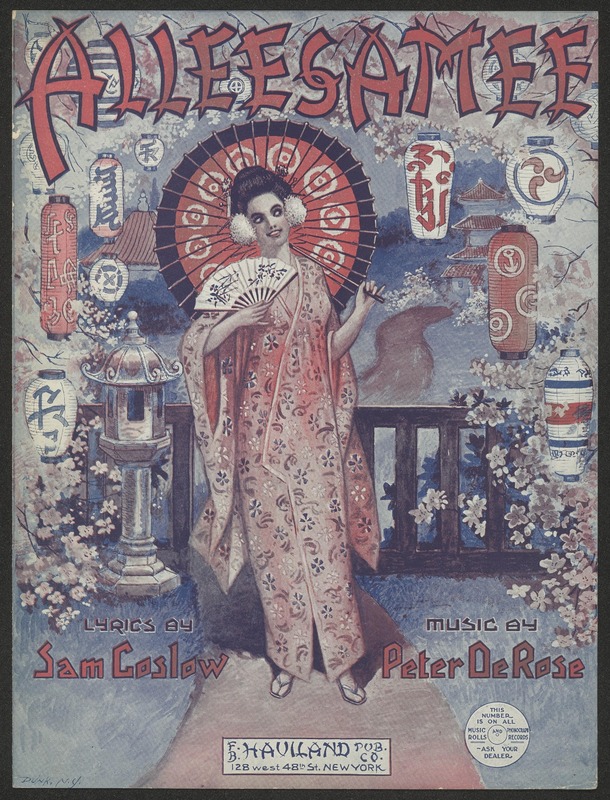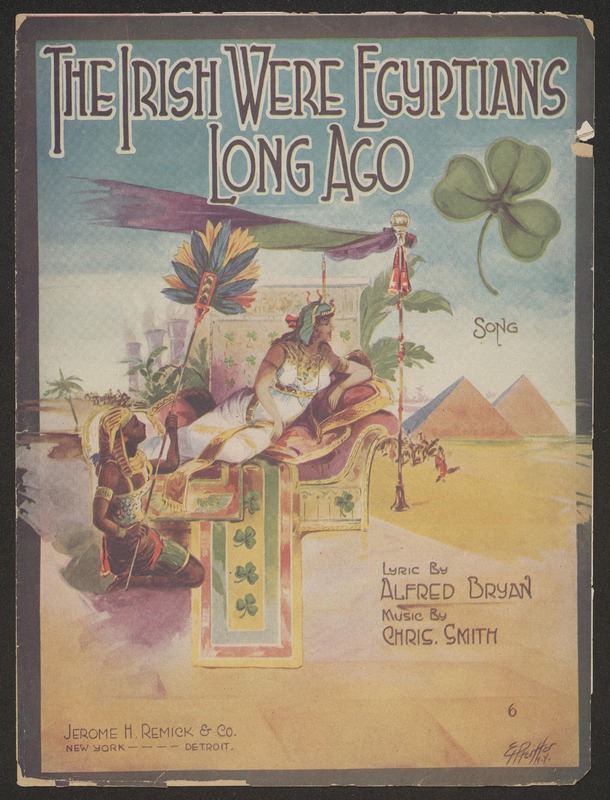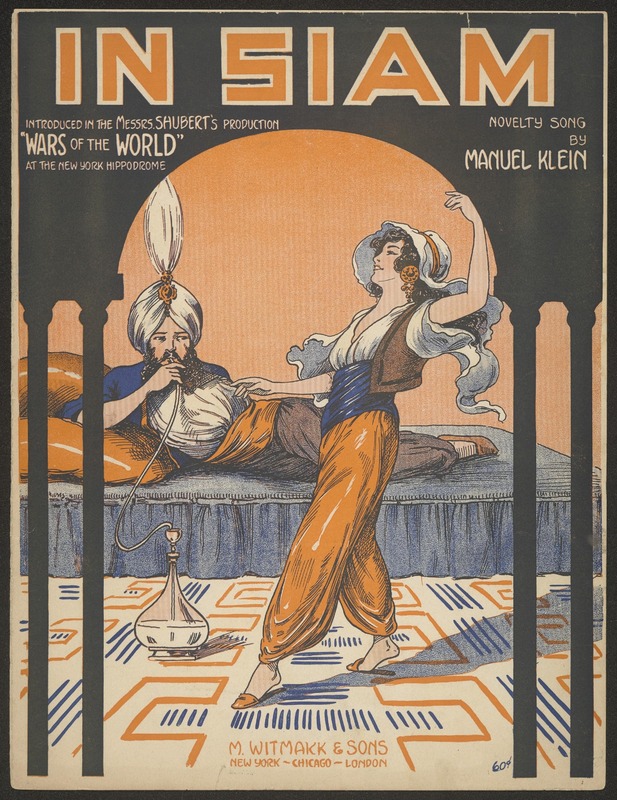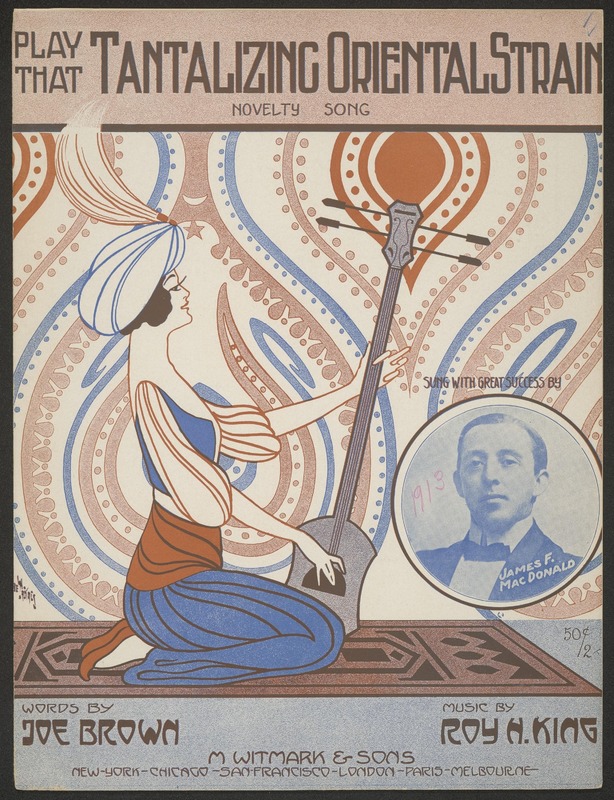Stereotypes
Alleesamee
Alleesamee, published in 1919, displays one of the most disturbing sheet music covers and lyrics in the collection. Splattered across the top of the cover is “Alleesamee” in a jarring, stereotypical “oriental” font. Below the title is a white woman with a terrifying smile and bulging eyes, wearing a traditional dress and holding a fan and an umbrella. The rest of the cover is crowded with cherry blossoms, lanterns with unintelligible characters, a pagoda in the background, and more items that may be perceived as Asian to outsiders.
Upon reading the lyrics, it becomes evident that the title, “Alleesamee” is a combination of “all” and “same”, demonstrating the blatant racism that people hold towards Asians by viewing every Asian as indistinguishable from one another. The rest of the lyrics explicitly mock the Asian accent while simultaneously sexualizing and fetishizing Asian women. For instance: “can you blame me for loving you”, “If you likee me like I likee you, plitty soon the wedding bells begin to ring Ching-ling-ling”, or “Nothing could be finer than your winky, blinky, chinky eyes of blue.” These disturbing lyrics display the obvious racism that Western artists exhibited towards East Asians, making fun of their accents, using racial slurs, and objectifying the women through the lyrics and the visual elements of the song.
The Irish Were Egyptians Long Ago
One particularly unique song is The Irish Were Egyptians Long Ago, published in 1920. On the album cover, a white woman is seen lounging on a throne or couch while a Black person kneels on the ground, fanning her. This immediately conveys a clear racial hierarchy that is prevalent in the song. However, both are wearing what is perceived as traditional ancient Egyptian clothing, and stereotypical symbols that connote Egypt are included in the background as well, such as the pyramids, palm trees, vast expanses of sand desert, and a distant line of people seeming to be riding on camels.
The song lyrics further patronize the Egyptians in a variety of ways. First off, the authors describe Egyptian writings as “weird and cryptic,” demonstrating how the country, its people, and their practices are viewed as foreign and othered. Afterwards, though, the lyrics state: “I’ve solved each strange inscription [...] And hold the mystic secret in my hands.” By describing Egyptian characters as something to solve and represent some sort of elusive power, authors are exoticizing the culture and practices, while also portraying it as something to conquer. The lyrics become more obviously demeaning, writing: “It must have been the Irish who built the pyramids/ For no one else could carry up the bricks. It must have been a Doyle who dug the river Nile/ For no one but an Irishman would fight a crocodile.” The authors discount the massive feats that the Egyptians have achieved, perceiving Egyptians as too incompetent and weak to genuinely have done so.
One unique ironic aspect of this song is that many Irish have also been discriminated against, manifesting itself in a genre of anti-Irish music. This song, though, seems to uplift and empower the Irish as a strong and dominant culture.
In Siam
In Siam (from Wars of the World) was published in 1914. The racism from this song is displayed through the stereotypes evident in its lyrics. More specifically, the authors effectively hypersexualize the entire country with lines such as: “They live their lives just so, with a hundred wives or so,” “polygamy is not considered a crime,” or “No place to let a bachelor/reformer go.” These lines depict Siam as a country where everyone is sex-obsessed and unable to control these impulses. Other aspects of the lyrics portray the country as incompetent, underdeveloped, especially compared to the U.S. or Western countries. For instance: “No one ever seems to hurry, And the motto “I should worry,” or “Affairs of state are out of date.” Overall, the lyrics of In Siam demean the country’s image, portraying it as a place where people sacrifice the organization of the society and state in order to satisfy their sexual pleasures.
Furthermore, the song cover and aspects of the lyrics demonstrate another form of racism through the melding of cultures. The architecture used to depict Siam on the cover is the same architecture largely used to depict the Middle East. The lyrics also continually use the term “rajah”, which means an Indian king or prince. None of these architectural forms or vocabulary originate from Siamese culture, demonstrating the racism the American authors exhibited by interpreting these entirely different world regions as a monolithic culture.
Play That Tantalizing Oriental Strain
Published in 1913, Play that Tantalizing Oriental Strain’s sexualization of Middle Eastern women is apparent even just within the title. This perception is further expanded upon in the lyrics, which says: “For when you do that dance, You’re simply in a trance.” The objectification of the dancing women is complemented by the perception of Middle Eastern “sultans”, who state: “Just do that dance once more! You can win my heart and throne.” While Middle Eastern women are depicted as only achieving power through their sexuality, Middle Eastern men are illustrated as incompetent, easily distracted and relinquishing their power at even the slightest attractions to women. Overall, this song and its lyrics show a dual-pronged approach in sexualizing Middle Eastern women while painting Middle Eastern men as inept.



